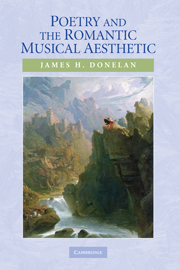Book contents
- Frontmatter
- Contents
- List of Musical Examples
- Acknowledgments
- Preface: The Sound and the Spirit
- Chapter 1 Self-Consciousness and Music in the Late Enlightenment
- Chapter 2 Hölderlin's Deutscher Gesang and the Music of Poetic Self-Consciousness
- Chapter 3 Hegel's Aesthetic Theory: Self-Consciousness and Musical Material
- Chapter 4 Nature, Music, and the Imagination in Wordsworth's Poetry
- Chapter 5 Beethoven and Musical Self-Consciousness
- Chapter 6 The Persistence of Sound
- Notes
- Bibliography
- Index
Chapter 4 - Nature, Music, and the Imagination in Wordsworth's Poetry
Published online by Cambridge University Press: 22 September 2009
- Frontmatter
- Contents
- List of Musical Examples
- Acknowledgments
- Preface: The Sound and the Spirit
- Chapter 1 Self-Consciousness and Music in the Late Enlightenment
- Chapter 2 Hölderlin's Deutscher Gesang and the Music of Poetic Self-Consciousness
- Chapter 3 Hegel's Aesthetic Theory: Self-Consciousness and Musical Material
- Chapter 4 Nature, Music, and the Imagination in Wordsworth's Poetry
- Chapter 5 Beethoven and Musical Self-Consciousness
- Chapter 6 The Persistence of Sound
- Notes
- Bibliography
- Index
Summary
Of course the work of art presents itself to sensuous apprehension. It is there for sensuous feeling, external or internal, for sensuous intuition and ideas, just as nature is, whether the external nature that surrounds us, or our own sensitive nature within. After all, a speech, for example, may be addressed to sensuous ideas and feelings. But nevertheless the work of art, as a sensuous object, is not merely for sensuous apprehension; its standing is of such a kind that, though sensuous, it is essentially at the same time for spiritual apprehension; the spirit is meant to be affected by it and to find some satisfaction in it.
Hegel, Lectures on Fine ArtHegel's distinction between the sensuous and the spiritual apprehension of art, like many of his ideas, continues to cast a shadow on literary criticism. His dismissal of “a speech, for example” as something other than art (despite the possibility that a speech might make occasional use of “sensuous ideas and feelings”) complicates the status of poetry by requiring it, as a true art form, to exist at once a material object and also as intentional, communicative discourse. As the previous chapter explained at some length, Hegel also points out that this dual existence in both the sensuous and spiritual realms is precisely what constitutes an object as art, separating artistic from natural beauty.
- Type
- Chapter
- Information
- Poetry and the Romantic Musical Aesthetic , pp. 97 - 135Publisher: Cambridge University PressPrint publication year: 2008



